Children's Institute 2018: Conversations with Featured Authors
Children's Institute 2018: Promoting Literacy and Sales with Book Festivals
Children's Institute 2018: Authors and Illustrators to Meet
Published on June 5, 2018 | In Blog, How To Begin Writing For Children | 0 Comment
 ABA’s mini–Winter Institute, focused on children’s books, authors, and bookselling, heads to the Big Easy to mark its sixth anniversary
ABA’s mini–Winter Institute, focused on children’s books, authors, and bookselling, heads to the Big Easy to mark its sixth anniversary"The Children’s Institute has become a vitally important part of ABA’s overall education efforts,” says Oren Teicher, CEO of the American Booksellers Association. “This year’s event offers more programming, more keynote talks, more authors, and more opportunities for booksellers to connect and share ideas, success stories, and their passion for building an even larger community of young readers nationwide.”
With more than 275 booksellers and more than 70 authors and illustrators planning to descend on New Orleans for Children’s Institute 6, to be held at the Sheraton New Orleans Hotel from June 19 to 21, attendance at the 2018 conference will be record breaking. The city, which is celebrating its tricentennial this year, will also host the American Library Association’s annual conference and exhibition from June 21 to 26.
Teicher notes that there will be more educational sessions—19 in total—than at previous Children’s Institutes, along with a “compelling roster” of keynote speakers and featured presenters. Much of the programming, particularly the talks, will focus on two topics that have long been flash points for ABA and the book industry as a whole: diversity and activism.
One of the standout sessions on diversity will bring together Wade Hudson and Cheryl Willis Hudson, husband-and-wife founders of Just Us Books, which has been publishing multicultural children’s books for three decades; writer Kwame Alexander; and Phoebe Yeh, v-p and publisher of Crown Books for Young Readers, in conversation about the forthcoming anthology We Rise, We Resist, We Raise Our Voices: Words and Images of Hope (Crown, Sept.), edited by the Hudsons.
In the closing keynote, Angie Thomas, author of The Hate U Give, will likely bridge both themes. She believes authors and booksellers must provide young readers with “as many opportunities as possible to expand their mind-sets.”
In another featured talk, former First Daughter Chelsea Clinton, vice chair of the Clinton Foundation, will advocate for a different type of activism. With her picture books She Persisted and She Persisted Around the World (both from Philomel), Clinton wants to empower the next generation with examples of diverse women who have made a difference.
Keynoter Temple Grandin, best known for her advocacy on behalf of those with autism and her autobiography, Thinking in Pictures, will talk about her debut children’s book, Calling All Minds (Philomel). In it she addresses the importance of creativity and thinking like an inventor; both were a key part of her life growing up and continue to be today.
Just Breathe (Running Press Kids, Aug.) author Mallika Chopra—founder of Intent.com, a platform focused on personal, social, and global wellness—will offer insights on balance and purpose during the conference’s opening keynote.
As part of the diversity effort, a central focus will be on ensuring bookstores are welcoming places for all. A session will be devoted to “Reaching Underserved Communities.” Another session will offer tips for reaching out to young people, regardless of their orientation: “Creating and Implementing Successful LGBTQ Youth Programs.”
Other programming gets down to the nuts and bolts of bookselling, starting with a 101-level seminar on the principles of bookstore finance. There will be a workshop on creating eye-catching chalkboards, as well as sessions on planning successful large-scale events and selling STEM and STEAM books.
Social media continues to be an important part of bookselling. To help, Eva Chen—director of fashion partnerships at Instagram and author of the debut picture book Juno Valentine and the Magical Shoes (Feiwel and Friends, Nov.)—will give pointers on how to build a bookstore brand at a special session on amplifying one’s presence on social media. The self-proclaimed “fashion nerd” has 884,000 Instagram followers and counting.
And no booksellers’ gathering would be complete without at least a few parties. In addition to the opening night reception and kid lit costume party, there will be a late-night screening party of the Netflix series Hilda. The show, which stars Claire Skinner, Daisy Haggard, and Bella Ramsey, is based on Luke Pearson’s Hilda graphic novel series. Scholastic is also bringing back its popular Meet & Treat After Party, open to all attendees.
Once home to William Faulkner, Tennessee Williams, and Truman Capote, New Orleans shares the 25th spot (with Tulsa) on the list of America’s most literate cities. It’s ahead of Miami, Phoenix, Memphis, and Los Angeles, to name just a few, when it comes to bookstores, libraries, and publications. But the city is also, as Teicher notes, “one of the most welcoming cities in the U.S.” In that spirit, Teicher continues, “All of us at ABA are looking forward to welcoming a record number of booksellers to what we hope will be the most successful Children’s Institute yet.”
Below, more on Children's Institute.
Children's Institute 2018: Conversations with Featured Authors
Children's Institute 2018: Promoting Literacy and Sales with Book Festivals
Children's Institute 2018: Authors and Illustrators to Meet
Sheraton New Orleans Hotel
500 Canal Street, New Orleans, LA 70130
(504) 525-2500
Questions can be directed to ABA's Jill Perlstein at jill@bookweb.org.
Published on May 24, 2018 | In Blog, How To Begin Writing For Children | 0 Comment
APRIL 02, 2018 | 0:22:33 Click on the link below to listen to this soulful interview.
Is there someone important you've never properly thanked? Find how award-winning children's book author, Yuyi Morales, discovers the power of writing a "gratitude letter" to the librarian who changed her life.
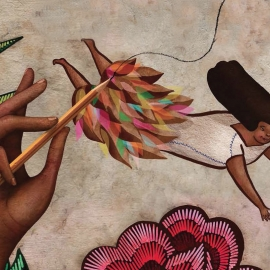 Transcript
TranscriptYUYI MORALES: I had just had a baby with my boyfriend at the time, an American citizen. I was in Mexico. When my son was 2 months old my then-boyfriend got the news that his grandfather was very ill. My future mother-in-law, she was very concerned that Grandpa Ernie, wasn’t going to be able to meet his only grandchild.
It was so unexpected.The only person I say, “Goodbye” was to my mother, because everything was so fast. And suddenly I was here in the United States, where I was told it was my new home.
And I spoke no English, really. Just a few words.I had this new baby, and I couldn’t communicate. So for a long time, I remember crying every day. I was lost.I didn’t know what I was doing here.
We moved to San Francisco. And right there, I discovered by walking with my son in his stroller, just exactly four blocks from my house was the Western Addition library. And that’s the place that really changed my life.
DACHER KELTNER: That library set Yuyi Morales on a path to becoming an award-winning children’s book author and illustrator. Her work has received some of the biggest awards in children’s literature including the Caldecott Honor.
Yuyi joins us today as our happiness guinea pig.
On every episode we have a happiness guinea pig try out a practice designed to boost happiness, kindness, resilience or connection. Then we explore the science behind why it works.
Yuyi welcome to the Science of Happiness.
YUYI MORALES: Thank you. I’m really happy to be here having this conversation with you.
DACHER KELTNER: You know, Yuyi, it’s so interesting to hear people’s stories and how they get to their particular happiness practice. So your gratitude letter is to a librarian, Nancy. Tell us about it.
YUYI MORALES: Nancy was…I mean, she probably doesn’t know it, but how important she is in my life. So this is a time in which, I’m very very afraid that I’m probably going to be doing something wrong because I still don’t understand how things work there. So it was Nancy who eventually came to me and she tries to, in her very own way, make me understand that the library is much more than I had realized.
She allowed me to feel that what the library has to do, was for me too. It wasn’t only for the people who was born here in the United States. It wasn’t only for the people who spoke English. It was also for someone, who like me, who didn’t understand, who had a little boy who was curious about everything, and someone who still feared that a place like that wasn’t for someone like me. And she, like many librarians I’ve gotten to meet, who are really my heroes, the way that they do their job is to let you know that the library is for everybody.
DACHER KELTNER: Yeah, that’s incredible. And books become your friends.
YUYI MORALES: They become my everything. My everything.
Here in the United States they make books that for me, will have been images that you will only see maybe at the museum. Or a gallery? And here they are, inside of books for children, that actual children can come and grab from the shelves.
DACHER KELTNER: No, it’s a sacred thing, just and I haven’t thought so much about how beautiful the artistry is. When did you, in this experience, when did you start to think about drawing and writing yourself?
YUYI MORALES: I guess it was shortly about that because the books amazed me. Every time I open a picture book, I could recognize a few words from there. But I could not understand the story. But, this is the magic of picture books. Then you look at the illustrations, and suddenly, you know what’s going on. And because that was kind of some of my first moments of understanding something, something, it was like finding a…I don’t know, a something or someone that you really fall in love with. That finally you have a connection with.
And I realized that I had a lot to say. That I had so many stories and so many things that I miss from my family, my country, that I wanted to share. And so what I did pretty much was that I copied. I tried to emulate. And I made handmade paper and used it to create covers for the books that I started making myself. And I just put them together with ribbons or with anything I found, and suddenly I had my books.
DACHER KELTNER: We’d love to hear your letter, Yuyi. Would you read it for us?
YUYI MORALES: I would love to read the letter for you.
Hola Nancy,
Do you remember me? I could never forget you. True, at first I might have been scared of you, guardian at your desk, and too close to the basket of baby books that my son always walked towards when we entered this unbelievable place. The children’s book section of the Western Addition public library.
I remember years later, when I was already working towards publishing my first picture book, I came to visit you. You told me that my expression had changed. “How so?” I asked. “In those days, in those first days, when you and Kelly came to look at books,” you said, “You always look sad.” Nancy, I was very sad. I was heartbroken. Feeling the weight of having to raise my son in a country where I didn’t know the language. And I could not make myself understood. A place where I felt very alone.
At first I might have been afraid of you. What if I made a mistake? Or broke the library rules? would you tell us to leave the library because we didn’t belong? Instead one day, you talk to me, in English I didn’t quite understand, and before we knew, you were giving Kelly a library card. I was puzzled. Kelly was barely two years old. How could he have anything?
Today, Kelly is a 24-year-old lover of books. He also writes. And he often helps me review and correct my still imperfect English when I write the children’s books I create. Books like the ones you put in my hands. Nancy, ever since the library became my home, and books became my path for growth, you have been an amazing guardian. Thank you.
DACHER KELTNER: I mean, it’s so incredible Yuyi, that the best moments that you find in these gratitude letters, kind of bring the mind to what’s sacred, and what I feel has been a real privilege to hear how this letter has been part of this amazing narrative of your life.
I just wanted to get your thoughts on what it was like to read your gratitude letter, and to use your voice to thank Nancy.
YUYI MORALES: I always felt very emotional about the role that the library had played in my life. But because I’m back in Mexico, I also feel like that’s part of my history now. Yes, it’s someone I was, but I felt like, maybe I could have left that emotion behind already? And then I had to write this letter and realized that the emotion is still there. The feelings and the gratitude and how this amazing thing happened … it is still there. So writing this letter made me feel that this is not only a history for me. This is an essential part of how I even live now, and the things I am doing nowadays. This is still very alive.
DACHER KELTNER: A space far away, but it’s still in you.
YUYI MORALES: Yeah. Exactly.
DACHER KELTNER: Why do you feel it’s so important to express gratitude?
YUYI MORALES: Wow. Because one of the things that I know more and more is that we can hardly do things alone. Most of the time, we need to hold hands with someone. And also, most of the time, the results of holding hands with someone is not going to be just for me. It’s going to be bigger than whatever I can get from joining somebody.
Every time I’m making my books, even though I might not be super conscious at the moment, once I’m done, I realize that what I’ve done is usually a celebration. I like the word celebration. And this celebration is part of recognizing how, not by myself, but with all these people on my side, far away sometimes, close by, we are all able to create something. These books really aren’t made just by me.
DACHER KELTNER: I know. Well I just feel so often, in some of the Science of Happiness, we make the mistake of looking in. And your wisdom about gratitude tells us it’s a very rich part of a whole story of community that creates things.
YUYI MORALES: Yeah. I wish that Nancy knew how much impact she had on me. And at the same time that Nancy embodies the presence of some other librarians that I don’t remember their names. I guess what I’m trying to say is Nancy is the embodiment of all this hard work…
DACHER KELTNER: These gracious hands.
YUYI MORALES: …yes, that librarians do.
And I guess that’s where, this process of also thanking all the people that extended their hand to me. This is the moment in which I come to reflect of everybody who was a part of me finally feeling like I had arrived to where I was supposed to be.
I’ve been working on a picture book that talks about this process. It’s called Dreamers. And this book, it’s kind of like a letter of gratitude to Nancy. I don’t mention her by name, but I depict her in a way I remember her. Always with her glasses here, ready to be used, on her forehead.
Dreamers is about these dreams we all, immigrants, have. And there is this belief that when we come to a country like the United States, we are coming here because we lack things. And I remember feeling like I had nothing. What am I bringing here? What am I offering?
And it took me awhile to realize that in fact I had brought so many things. And in Dreamers, I think that’s what my voice is trying to say. That we immigrants carry so many things with us That we bring our stories. We bring our voices. We bring our memories. We bring our colors. And once I arrive here, like many immigrants, we do put that in the table. We bring our arms, we bring our strength, we bring our work, we bring our creativity.
Although my son was not a Dreamer in the sense of Dreamers who are these kids who are brought as infants, as children to this country, and know no other country but the United States as their own country. But we are the kind of dreamers, like all the people who come to a country, hoping that we bring the best that we can, to create a better life. Not only for us. For our children, and for the rest of the world.
DACHER KELTNER: Yuyi, your books are beautiful and sublime and changing the world. It shouldn’t surprise us that your books have won just about every award. You received the Caldecott Honor Award. What was that like?
YUYI MORALES: It was amazing! And it just really validated that our voices are important. That even a voice as imperfect as mine, you know this voice that still needs correction and help and patience and everything, that it has a place where it is heard. And I want to give a shout also to the Pura Belpre award, because a lot of people get to know about the Caldecotts. But not a lot of people get to know about all the other authors and illustrators who are doing amazing jobs. And they are not in the mainstream. They are not as visible to the rest of the readers of the country. And awards as the Pura Belpre, the Coretta Scott King award, many of these awards, what they are saying is, there are many more voices that we don’t hear. And here are they. Let’s listen.
DACHER KELTNER: You know in the scientific literature, we define gratitude as the reverence for things that are given. And I revere the words, and the voice, and the stories and the images in your books, and everything that you are giving people. We’re very lucky to have had you on our show. Thank you for teaching us so much about gratitude.
YUYI MORALES: It has been a lesson for me too. Thank you for this opportunity.
If you want to try writing a gratitude letter or other practices like it, find simple instructions on our website Greater Good in Action, that’s G-G-I-A dot Berkeley dot edu. Then email us and let us know how it went!
DACHER KELTNER: The gratitude letter had a powerful effect on Yuyi, and she’s not alone. Studies have found that writing a gratitude letter, and reading it aloud, can give a significant boost to your levels of happiness, even for several months.
Published on May 7, 2018 | In Blog, How To Begin Writing For Children | 0 Comment
by Chazda Albright | Jun 26, 2017 This entry is part 20 of 23 in the series Publishing Biz
Who are the publishers accepting submissions3 directly from authors and illustrators these days - but who are still SOLID and reliable? Here’s my list. (I’ll be updating this every so often.)
Just added SIX new publishers to this list, and updated an older link from Peachtree.
 This is a rare list of reputable publishers who are currently accepting submissions - without requiring an agent be involved.
This is a rare list of reputable publishers who are currently accepting submissions - without requiring an agent be involved.
artwork by Ivan Tamas
If you’ve finally decided to stop worrying about the best way to get published and are now ready to simply start submitting your work to some publishers, this is for you.
I’m a big advocate of Hybrid Authoring, essentially getting published via any and all ways. Self publishing will enrich your scope of knowledge and give you a greater appreciation for all the work that goes into getting a book on the market, and traditional publishing gives you other opportunities that will simply blow your mind (money, connections, clout).
The traditional publishing business is slow. If you’ve ever worked with someone in the publishing world, you know this well. Time and patience are required - for many reasons, and all of them are valid.
What’s known as The Big Four publishing companies (Simon & Schuster, HarperCollins, Penguin Random House, and Hachette Livre), we know, all have serious weight. Getting published by one of these monster businesses means you’ve stepped up to seriously deal. Oh yah!
The big publishing houses (and most of their imprints) will not look at your manuscript if it doesn’t come from a literary agent (seriously, they’ll just toss it in the bin or hit “delete”). If you’re working on getting an agent - great. But finding and winning over the right agent takes time too. (Naturally.)
That doesn’t mean your only option is to self publish like mad until a savvy-agent-with-heart notices your brilliance and plops a fabulous offer to represent you - right into your lap. Ahem. Self publish, sure - but don’t stop there.
You can get published traditionally while waiting to hear back from an agent (and while self publishing your more niche stories). So how do you get your work published if you don’t yet have an agent?
While you’re busy looking for the right literary agent, there’s no reason to put your writing career on hold. You can submit one of your manuscripts to publishers who don’t require agents - while waiting to hear back from those literary agents.
WARNING: Do not submit the same manuscript. Choose one manuscript to send to your prospective agent(s) and another, completely different, manuscript for publisher(s) to consider.
Don’t worry - you’ve got to start somewhere, after all! But if you want to pursue all your publishing options, you need to treat those options exclusively. It’s extremely rare that any publisher or agent would consider publishing a book you’ve already published yourself. WHY? Because it means First Rights are off the table.
What this means is that you’ll want to have one manuscript to self publish, another manuscript to submit to agents, and a third manuscript to submit to publishers directly.
If you currently have one title, you could submit it to publishers as a first step. While you’re waiting to hear back from the publishers, you’ll be busy working on another book, which you can self publish.
NOTE: Don’t self publish the first manuscript unless it’s been 4-6 months since your last submission - yes, it can take that long to get a response. (I once got an offer 11 months after I submitted.) So send out your submissions and just let it ride - in fact, forget about it so you can get on with the next project.
Once your self published book is selling and your first manuscript is either still waiting with publishers or getting a deal, you can start writing another story. It being your third book, you’ll be ready to seriously contact literary agents about it.
Finding publishers - professional, For Real Publishers who know what they’re doing - is an entity all writers need to hunt down. It’s tough work, so I thought I’d help you out.
Here is my list of reputable publishers (and whose names you should get to know) who publish kid’s books (baby books up through young adult) each year and who (currently) accept submissions directly from writers and illustrators.
My one gripe: publishers who accept submissions very often require snail mail submissions. For me, living in Germany, this is a deal breaker because I cannot afford to send full-color manuscripts across the sea (and it’s a waste of paper). Still, I’ll leave it to you to decide what works for you and what doesn’t.
Some of the publishers listed here do accept email submissions, and for that I’m grateful. I’ve provided direct links to each of the publisher’s Submissions Guidelines. Be sure to follow them to the letter (if you don’t, that’s reason enough for a rejection).
Unsolicited manuscripts are manuscripts submitted directly from a writer rather than through an agent.
The following publishers range greatly in size and also in the types of books they publish for kids. Some are independent, some are imprints. Each one has its own style, and even if their philosophies sometimes sound similar, the books each publisher brings to the market vary quite a bit.
What all of these publishers have in common is that they
If you should find that any of these publishers have changed their policy on one of these four points, please let me know so that I can update the list.
Albert Whitman & Company “All Albert Whitman & Company books treat their readers in a caring and respectful manner, helping them to grow intellectually and emotionally. We are dedicated to continuing our tradition of creating award-worthy books for children.” -from the publisher website.
Bancroft Press “The most interesting thing about Bancroft Press is that, as of 2014, the company has survived for twenty-three years without a niche.” -from the publisher website.
Barron’s is most known for their textbooks and educational materials. But they also publish coloring books and children’s books that have a storyline that teach an important lesson or interesting topic.
Bebop Books (imprint of Lee and Low Books) “Lee and Low is a quality children’s book publisher that specializes in multicultural themes.” -from the publisher website.
Bess Press “Our goal is to regularly provide customers with new, creative, informative, educational, and entertaining publications that are directly connected to or flowing from Hawaiʻi and other islands within the Pacific Region.” -from the publisher website.
Boyd Mills Press Highly respected publisher of all kinds of wonderful books. Follow this link to read about the company’s different divisions. Great stuff.
Capstone “Helping children develop a love of reading and learning, no matter their ability level, is at the heart of what we do at Capstone. Our passion for creating inspired learning has made us the most trusted publisher of children’s books and digital solutions for libraries, classrooms, and consumers for 25 years.” -from the publisher website.
Charlesbridge “Charlesbridge publishes high-quality books for children, with a goal of creating lifelong readers and lifelong learners. Our books encourage reading and discovery in the classroom, library, and home.” -from the publisher website.
Chronicle Books This San Francisco based publisher produces high quality books and novelty items designed for gift-giving (all ages). Very beautiful books.
Creston Books has only been around since 2013, but they’ve quickly established a strong reputation. In just four years they’ve won over 20 awards. Fully a third of their list is by first-time authors, so this is your chance!
Dawn Publications “Dawn Publications is dedicated to inspiring in children a deeper understanding and appreciation for all life on Earth. We aim to help parents and teachers encourage children to bond with the Earth in a relationship of love, respect, and intelligent cooperation, through the books we publish and the educational materials we offer online.” -from the publisher website.
Dial Books for Young Readers “Dial Books for Young Readers is a hardcover division publishing approximately seventy titles per year for children of all ages, from preschool through young adult.” -from the publisher website.
Eerdmans Books for Young Readers “These children’s books tell delightful stories about adventure, family, and friendship, but they also help children wrestle with special issues, such as grief, divorce, racism, poverty, and war.” -from the publisher website.
Flashlight Press is an indie publisher with international distribution and they publish “books (that) explore and illuminate the touching and humorous moments of family situations and social interactions through captivating writing and outstanding illustrations.”
Flux “Flux is an imprint of North Star Editions, Inc., a privately owned publishing company dedicated to guiding readers toward a lifetime love of reading. NSE publishes fiction and nonfiction for children and young adults that inspires, informs, and entertains.” -from the publisher website.
Gibbs Smith This is a large publisher who does all sorts of hardback full-color books. All their titles are visual, nonfiction or fiction.
Hachai Publishing “Children’s books play a vital role in every Jewish home, classroom and library. Hachai Publishing is dedicated to producing high quality children’s literature with Jewish themes.” -from the publisher website.
Holiday House Books for Young People was founded in 1935 and publishes everything from picture books to young adult.
Immedium publishes childrens books that are quirky, innovative and appealing to boys and girls. Their catalogue is international, both in style and themes.
Lerner Books “Lerner Publishing Group is one of the nation’s [the US’s] largest independently owned children’s publishers with more than 5,000 books in print.” -from the publisher website.
Lerner doesn’t generally accept unsolicited manuscripts, but it will open their doors at specific times to writers without agents. Follow the company blog for announcements (pay particular attention around October-November).
Ken Bar Publishing (an imprint) accepts unsolicited submissions.
Magination Press This is a seriously cool imprint of the APA (American Psychological Association), which is “the world’s largest association of psychologists, with more than 117,500 researchers, educators, clinicians, consultants and students as its members.”
What they publish are books for kids (from pre-readers to teens) about really tough topics. For example, a book about how a toddler deals with death, or ADHD.
Mighty Media Press is a multi-media publisher (including books) of childrens books and they have a positive mission behind their choices. “Our mission is to deliver captivating books and media that ignite a child’s curiosity, imagination, social awareness, and sense of adventure. And we take our mission seriously.”
Milkweed Editions is probably best known for their successful Kickstarter campaign (you can check it out here). This publisher’s motto is: “Bookshelves should never be boring.” This is a nonprofit indie publisher of fiction, nonfiction and poetry, and they also publish Middle Grade and Young Adult titles.
Peachtree Publishers “Peachtree Publishers is an independently owned trade book publisher, specializing in quality children’s books, from picture books to young adult fiction and nonfiction.” -from the publisher website.
Submissions Guidelines (The Peachtree website has been updated and this is the new link. Check it out!)
Persea Books “is an independent, literary publishing house founded in 1975 by Michael Braziller and Karen Braziller, who still own and direct the company.” Recently, the publisher has decided to branch-out into YA novels.
Sleeping Bear Press “Since our first success with The Legend of Sleeping Bear in 1998, Sleeping Bear Press has impressed young readers, parents, teachers, and booksellers with high-quality, beautifully illustrated picture books.” -from the publisher website.
Stripes Publishing (an imprint of Little Tiger) “Please note, Stripes publishes fiction for children aged 6–12 years and teenagers. We do not accept books for adults, educational books, poetry, graphic novels, comics, multimedia, scripts, screenplays, short stories, non-fiction or picture books for babies and toddlers.” -from the publisher website.
Top That Publishing “Top That Publishing Ltd is an award-winning, book publisher and app developer located beside the river Deben in Woodbridge, Suffolk, UK.” -from the publisher website.
Turner Publishing “Turner Publishing Company is an award-winning, independent publisher of books. The company is in the top 101 independent publishing companies in the U.S.” -from the publisher website.
Workman Publishing “The Workman imprint publishes exclusively nonfiction books for children and adults, as well as calendars.” -from the publisher website.
Don’t be shy about submitting your work. Not if you’re certain it’s well edited and really ready to go. If you’re not quite sure about THAT - I highly recommend asking someone for help. Here’s howto give and get helpful critiques so that your manuscript will really shine.
What about you? Are you submitting or planning to submit one of your manuscripts somewhere? Write below, let me know - or, as ever, send me an email. I’d love to know what you’re doing.
Keep creating, no matter what.
Published on May 5, 2018 | In Blog, How To Begin Writing For Children, Independent, Hybrid and Self-Publishing | 0 Comment
 Posted on by Jane Friedman This post was first published in 2011 and is regularly updated.
Posted on by Jane Friedman This post was first published in 2011 and is regularly updated.
If you have a book idea or a manuscript, one of your first questions is probably:
How do I find a publisher?
Or, if you’re more advanced in your knowledge of book publishing, you may ask:
How do I find a literary agent?
The good news: there’s no shortage of resources for researching publishers and agents. The bad news: you can really get lost going down the rabbit hole of available information!
In the United States, the most comprehensive resource (published since 1920) is the annual Writer’s Market directory, which is also available and searchable online at WritersMarket.com. It features more than 8,000 listings of where you can get published and includes literary agents. While it does cost to purchase the guide (or subscribe online), you can often find it at your local library or bookstore.
Alternatively, you can find a range of free and paid resources online. Some of the sites and tools listed below offer submission trackers, community message boards, and interesting statistics gathered from official site members.
Here’s a summary of the most well-known and popular places to find publishers and agents.
Be aware that most New York book publishers do not accept unagented submissions, so sometimes “searching for a publisher” really means finding an agent (see next list).
Before you begin a search in earnest, be sure to read my post: How to Find a Literary Agent
Some writers really dislike conducting this research. While I think writers should undertake this task for themselves, if you prefer to hire someone to find appropriate agents and publishers for you to submit to, try Grad Student Freelancers.
 Jane Friedman (@JaneFriedman) has 20 years of experience in the publishing industry, with expertise in digital media strategy for authors and publishers. She is the co-founder and editor of The Hot Sheet, the essential newsletter on the publishing industry for authors.
Jane Friedman (@JaneFriedman) has 20 years of experience in the publishing industry, with expertise in digital media strategy for authors and publishers. She is the co-founder and editor of The Hot Sheet, the essential newsletter on the publishing industry for authors.
In addition to being a columnist for Publishers Weekly, Jane is a professor with The Great Courses, which released her 24-lecture series, How to Publish Your Book. Her book for creative writers, The Business of Being a Writer(University of Chicago Press), received a starred review from Library Journal.
Jane speaks regularly at conferences and industry events such as BookExpo America, Digital Book World, and the AWP Conference, and has served on panels with the National Endowment for the Arts and the Creative Work Fund. Find out more.
Published on May 1, 2018 | In Blog, How To Begin Writing For Children | 0 Comment
 Writing for Kids (While Raising Them)
Writing for Kids (While Raising Them)
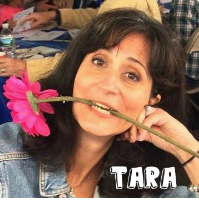
Blog & website of children's book author Tara Lazar, February 22, 2009
As a children's book author and mother of two, I'm pushing a stroller along the path to publication. I collect shiny doodads on the journey and share them here. You've found a kidlit treasure box.
Editorial Anonymous provided a great explanation of basic picture book construction a few months ago.
At that time, I skimmed the info. Today, I’m studying it.
Why? An editor asked me to make page breaks on my current manuscript. And know what? I had more page breaks than a 32-page picture book would allow! Whoops. I knew that my manuscript had to fall within the 500- to 800-word length, but I had neglected to pay attention to logical page breaks.
The editor said, “Page turns can make or break a book, and it can be helpful to an editor to see how you envision the text.”
In a 32-page picture book, you don’t actually have 32 pages for your story. You only have 24 pages since 8 are used for the book ends, copyright and title. And 24 pages translates to 12 spreads (an illustration that spans the two opened pages in a book).

Self-ended means that the printed book block serves not only for the story, but also for the end pages. No additional paper is used to form the book. The printed book block is pasted directly onto the cover.
Another common format is colored ends. This means colored paper (different from the printed book block) is used for the end pages. With colored ends, you’ll gain an additional 2 1/2 spreads since more of the printed book block is available for story.
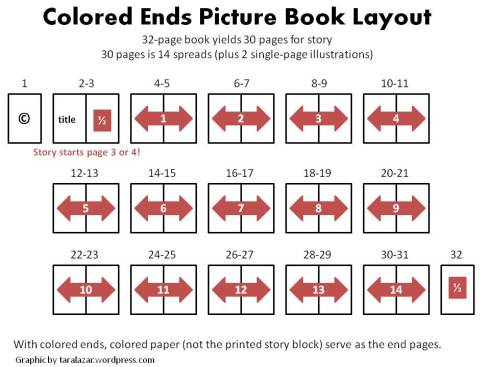
Some picture books have single-page illustrations instead of spreads. One of my favorite devices is when a group of three things are illustrated on one page. But this isn’t done on every page. A debut author’s work might be laid out only in spreads to save on costs (it’s less illustrations to produce), so you may want to think mostly in spreads. As always, publishing is a subjective industry, so this will vary by editor.
You may be asking, why do I need to know this? Won’t the editor and illustrator figure out the page breaks? Sure, they will. Some may not even ask for your page-break input. However, you can write a more appealing picture book if you understand the format for which you’re writing. Knowing the page turns will improve your story’s pacing. You’ll realize which scenes may have too much text. You can make page turns surprising and fun.
So give it a try. Take your current PB and plug it into the format. Does it fit?
I just took a random sampling of 7 picture books from my collection. Interestingly, none had self-ended construction. They all had colored ends. Here’s how they broke down:

I don’t think I’ll ever look at a picture book the same way again. My kids are going to be frustrated if I count spreads while I read to them!
It’s interesting to note that Cowboy Camp and Spaghetti Eddie are both by debut authors. Cowboy Camp is illustrated in spreads, whereas Spaghetti Eddie is told with mostly single-page illustrations. This “illustrates” that publisher preferences vary (as do manuscripts)!
Keep in mind that when you submit your manuscript, you should do so in the standard format, unless the submission guidelines specifically request that you mark page breaks.
Some editors will never ask you for page breaks, some will insist upon them. Remember that this is a subjective industry where there are many rules to follow but many places to break them, too.
Published on May 1, 2018 | In Blog, How To Begin Writing For Children, Recommended Books | 0 Comment
for the BookBaby Blog April 20, 2018
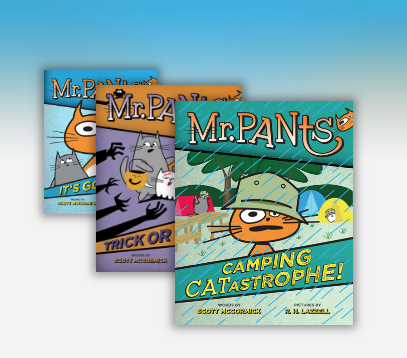 Mr. Pants Series by Scott Mccormick and R. H. Lazzell A laugh-out-loud comic hybrid series about the antics of three goofball cats, perfect for beginning readers and fans of Bad Kitty and Squish.
Mr. Pants Series by Scott Mccormick and R. H. Lazzell A laugh-out-loud comic hybrid series about the antics of three goofball cats, perfect for beginning readers and fans of Bad Kitty and Squish.Maybe you don’t need panic-induced adrenaline to write, but I do. That’s why my agent’s submission deadlines were the best thing for my book series.
My agent called. “Scott, good news. Your publisher wants two more Mr. Pants books.” To say that I was surprised would be an understatement. After all, my first book, Mr. Pants: It’s Go Time, hadn’t even been published yet. “The only thing is,” he continued, “they need a finished manuscript in two weeks.”
It had taken me three months to write book two, and I hadn’t even started from scratch. I had started from a few short stories I had left over from writing book one. But here I was, with just two weeks to write a book, and I didn’t have any (good) Mr. Pants stories in the tank; just a discarded attempt at a book that was tentatively called The Camping Catastrophe.
So: Two weeks to produce a 128-page graphic novel from scratch? There was no way.
Then the panic set in. It felt great.
“No problem,” I said.
Panic as a motivator
Hemmingway wrote every morning. Most successful authors seem to have similar habits. I can’t. I’ve tried. I just get frustrated.
Sometimes I get lucky and an idea will just come to me and I’ll rush over to my computer (or whip out my phone) and start banging away until I have taken the idea as far as I can. But those moments of inspiration are rare.
Instead, I need a deadline. I discovered this in college. I wrote every single paper at the last minute — not because I was procrastinating, but because I literally couldn’t write unless I was in a state of panic.
When I’m calm and happy, it’s hard for me to push myself to write creatively. But when I’ve got just two hours to come up with a major ad campaign for my whale of a client? The adrenaline kicks in, the ideas start flowing, and my mind goes to weird places.
Knowing this, I tell my clients to give me a hard, short deadline for everything. Sometimes they forget, or they tell me there’s no rush. “That won’t work,” I tell them. “Lie to me. Tell me you need it Tuesday. Bonus points if you use the phrase ‘mission-critical.’”
After hanging up with my agent, I thought about the amount of money I could potentially blow if I didn’t turn my manuscript in on time. It was a glorious thought. I was giddy from panic.
My mind zipped from idea to idea. All of them were terrible. Then, out of nowhere, my mind went to one of those glorious weird places. I thought of Dawn of the Dead, the 1978 zombie classic that was so gory the MPAA threatened to give it an X-rating, forcing George Romero to release it without a rating. It was one of my favorite movies.
“That,” I said, fully embracing the state of panic-logic, “would make a great children’s book.”
Running out of time
My editor called me the next day to discuss my ideas. I told her about Camping Catastrophe, since that was the concept I was closest to having finished. In the day since hanging up with my agent I had figured out everything I needed to finish that book: I had the basic concept and I knew the arcs for all of my characters. All that was left for me to do was, you know, write the book. But I knew I’d be able to get that done in time. After all, I was in panic mode.
My editor liked the camping idea, but she worried about the publication date. Book three was scheduled to come out in the fall, and she was concerned that this story would be more suited to a summer release, when more people camp. She asked me what else I had.
I had nothing else. But I couldn’t say that. And before I could stop myself, I said, “Have you seen Dawn of the Dead?”
In the movie, the main characters are trapped in a mall. As a tween, when I first saw the film, I remembered loving that whole notion of having a mall as my personal playground. So, I launched into a spiel about how it might be fun to have Mr. Pants and family trapped somewhere like a mall, or, as I suggested, an airport.
I was walking a fine line. I was trying to make it sound like I had another good idea when I didn’t, but at the same time, I was trying to make it sound like this idea was worse than Camping Catastrophe, because I had no idea how to build a story around this idea.
To my chagrin, she liked the airport idea. I asked her to like the camping idea.
We ended the call with her saying she’d run the two concepts by her boss and get back to me. But I was running out of time.
All thanks to panic
Unfortunately, agents aren’t often calling me with these tight deadlines. In fact, it’s happened exactly once.
But I still need that sense of panic to write. So, if I want to write something creative, something that doesn’t have any actual deadlines, I have to find ways to trick myself.
One trick I have used in the past is to write with a partner. That’s how the Mr. Pants books came into being, I teamed up with an illustrator friend of mine and I made him give me deadlines.
But I’ve also learned to team up with other writers, even if we’re not working on the same project. They write their book, I write mine, and we check in with each other at the same time each week to share what we’ve been writing. I usually put off writing anything until 5 pm on the day before our meeting. I have an alarm on my phone, which gives me that, “Oh crap! It’s Tuesday already?” feeling so my mind can go where it needs to go.
Knowing that someone else is depending on me is enough to give me a reason to panic.
I didn’t have time to wait to hear back from my editor, so I decided to finish Camping Catastrophe. It took me about six days or so to write the first draft and another two days to for the rewrite.
I was rather happy with it.
My editor called. She said exactly what I knew she would say. They definitely wanted the airport story.
“How’s it coming?” she asked.
“I finished Camping Catastrophe,” I said.
“Good. Send that one too.”
I had four days left, and I had nothing to work with but some vague notion that my characters would be trapped in an airport.
Full-on panic mode.
I spent a day and a half trying to figure out one important thing: Why were they at the airport? Where were they going to? Or coming from? More importantly, what did Mr. Pants want?
In (basically) every work of fiction, your protagonist needs a goal. That’s what drives the story forward. In book one Mr. Pants’ goal is to play laser tag. In book two he wants to make a movie. In Camping Catastrophe he wants to join a Boy-Scout-type organization. But I struggled to figure out what he wanted or needed in this airport.
I couldn’t think of anything. I had a bunch of false starts, but they were all terrible.
I was way beyond panicked. I was losing it.
Frantically searching for ideas, I went back to the reason why my editor didn’t want Camping Catastrophe. Timing. Book three was scheduled to come out in the fall, and she had thought the camping story would be more appropriate for the summer, which is when book four would come out. OK, I thought, what else happens in the fall?
And then it hit me: Halloween.
That one word unleashed a torrent of answers. At once I knew why my characters were at the airport. I knew what Mr. Pants wanted. I even knew how to get in a nice shout-out to Dawn of the Dead, by having my characters play an airport-wide game of zombie tag. It all came together, and I was able to finish my manuscript in just four days. My editor loved it. Mr. Pants: Trick or Feet was published a year and a half later and even got a write up in the New York Times Magazine.
All thanks to panic.
Maybe you don’t need panic-induced adrenaline to write. That’s great. But if you’re feeling uninspired or you just want to try something new, give it a shot. Set up a deadline somehow. Make the consequences of failure significant. Embrace the panic. Let your mind go to weird places. And start writing.
 In All, All The Wonders Podcast, Podcasts by Matthew Winner,
In All, All The Wonders Podcast, Podcasts by Matthew Winner,
Scott McCormick (@I_am_Mr_Pants) and R.H. Lazzell (@rhenrylazz), author and illustrator team behind Mr. Pants: Camping Catastrophe and other books in the Mr. Pants series, stop by the podcast to talk about breaking convention, kids who never read, and how to remain funny.
Thanks for listening to All The Wonders: The Children’s Book Podcast! If you enjoyed this episode, subscribe to the podcast on iTunes or on the Stitcher radio app. There you’ll find an archive of every episode of the podcast. You’ll also have an opportunity to leave a review or some stars. If you do, hugs and high fives are coming your way. Thanks for inviting us into your ears and for your support!
Published on April 1, 2018 | In Blog, How To Begin Writing For Children, News | 0 Comment
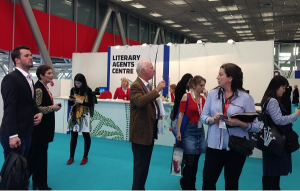 photo: Dealmakers and scouts gather to talk trends at the rights center at the Bologna Children's Book Fair.
photo: Dealmakers and scouts gather to talk trends at the rights center at the Bologna Children's Book Fair.While there may not have been a single book that agents and scouts were buzzing about in the rights center at this year’s Bologna Book Fair, insiders were not at a loss when it came to identifying trends in the marketplace. Among the more notable takeaways were the fact that middle grade fiction remains hot, and the political upheaval in the United States—from movements like #MeToo to #BlackLivesMatter—is reverberating around the globe, and driving interest in titles, both fiction and nonfiction, that speak to this tumultuous moment.
Rachel Hecht, who runs an eponymous children’s scouting firm, said she’d been noticing an uptick in nonfiction titles addressing things like “feminism and activism.” Acknowledging that the hunger for these books is likely being driven by current events, Hecht said publishers are also reacting to the bestseller lists and what’s working in the market. Citing breakout successes like Good Night Stories for Rebel Girls and Angie Thomas’s The Hate U Give, Hecht said publishers around the globe are looking for books that address and grapple with diversity in myriad ways.
A film scout who specializes in children’s literature said that, on the screen side, there were a number of titles circulating (or just sold) drawing comparison to Netflix’s breakout series, Stranger Things. One such buzzed-about project is Rena Barron's middle grade fantasy series Maya and the Rising Dark, which had just sold to Emilia Rhodes at Houghton Mifflin Harcourt in a three-book preempt for world English rights.
Barron is represented by Suzie Townsend at New Leaf Literary & Media, and made headlines last year when her manuscript, The Last Witch Doctor, became one of the most sought after titles to come up through the PitchWars contest (which offers authors an opportunity to showcase an un-published project).
Maya and the Rising Dark, New Leaf said, is a West African inspired tale. The middle grade series (which is unrelated to The Last Witchdoctor), is, per the scout, like Stranger Things "if the kids had magical powers." It follows the titular heroine who, along with her friends, is on a quest to save her father. When Maya discovers that her missing parent is "the keeper of the gateway between our world and The Dark," she and her friends must "unlock their powers" and venture into the Dark to "face mythological creatures set on starting a war."
A representative from New Leaf explained that The Last Witchdoctor has evolved into a YA fantasy series and sold in a separate deal, which has not yet been announced. Details about the sale of The Last Witchdoctor will be released during the forthcoming London Book Fair, with the first title in that series set to become Barron's debut. New Leaf noted that TLWD also features "West African inspired mythology and magic."
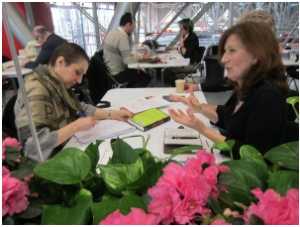 The surge in content featuring Stranger Things-esque elements was something agent Fiona Kenshole at the Canada-based Transatlantic Literary Agency was also noticing. “SF is having its moment,” she said. Kenshole felt the appeal of such content was thanks to the Netflix series, in which a quartet of friends fight demonic creatures that exist in another dimension which can be accessed through various portals in their Midwestern town. (The alternate dimension in Stranger Things is, as in Barron's MG series, called "The Dark.") photo: Fiona Kenshole (r.) of Transatlantic Agency, meeting with Marzena Currie, a scout with Eccles Fisher Associates.
The surge in content featuring Stranger Things-esque elements was something agent Fiona Kenshole at the Canada-based Transatlantic Literary Agency was also noticing. “SF is having its moment,” she said. Kenshole felt the appeal of such content was thanks to the Netflix series, in which a quartet of friends fight demonic creatures that exist in another dimension which can be accessed through various portals in their Midwestern town. (The alternate dimension in Stranger Things is, as in Barron's MG series, called "The Dark.") photo: Fiona Kenshole (r.) of Transatlantic Agency, meeting with Marzena Currie, a scout with Eccles Fisher Associates.
U.K. scout John McLay noted that YA titles seemed to largely be traveling “one way, [from] the U.S. to the U.K.” Middle grade is, he felt, quite strong in his native U.K. “[The Americans] do YA the best, and I think we do middle grade quite well.”
One recent trend, largely created by the international success of One of Us Is Lying by Karen McManus, is the emerging popularity of the YA thriller. Agent Rosemary Stimola, who reps McManus and sold One of Us Is Lying into 37 languages, was showing the author's second book, Two Can Keep a Secret, which Delacorte will publish in January 2019, to foreign publishers for the first time here. "Option publishers have the first look, of course," she said, noting that by Wednesday morning she had "already sold seven." She said the book has shown publishers around the world that "there is an established market for the YA thriller."
For the Bent Agency’s Molly Ker Hawn, the first priority of the day was the international interest she was fielding in a YA novel called All of This Is True, which just so happens to cite One of Us Is Lyingas its main comp title. (Bloomsbury will be publishing the book in the U.K. on May 15; in the U.S. it will be released by Harper, on May 30.) The novel, by Lygia Day Peñaflor, is told through interview transcripts and diary entries, and follows four teenage friends whose attempt to befriend their favorite author winds up yielding dire results. Hawn, who had just closed a new deal for the book with a Czech publisher, said she felt All of This Is True was speaking to an interesting and recent cultural moment, in which young readers have unprecedented access to beloved writers.
Aside from All of This Is True, Hawn said that she was also seeing an intense interest in middle grade titles. And, echoing some of her colleagues, she noted that co-agents she works with in the U.K. have been “spending a lot of money” on the books in the category.
For Jennifer Weltz at the Jean V. Naggar Agency, the fair season has brought an unexpected but welcome interest in backlist titles. With some of that interest being driven by film adaptations, Weltz said she was also seeing a rise in demand for classic children’s books.
Weltz, who oversees the estates of such children’s book authors as Alvin Tresselt and Roger Duvoisin, said that, in the past, Europe had not been a market for backlist picture books. No longer. “What’s being called the ‘vintage book market’ is growing,” she said, noting that European publishers are recognizing the fact that young parents, who grew up with certain classic picture books, are now interested in reading those same titles to their children.
On other fronts, Weltz noted that a wider embrace of diverse titles was opening doors for other kinds of backlist books. Emily Danforth’s 2012 novel The Miseducation of Cameron Post, which is the basis of a film that premiered earlier this year at the Sundance Film Festival, is an example. A coming-of-age tale about a young Montana girl discovering her homosexuality, the novel was not something Weltz was able to sell to a wide swath of international publishers when it was first released.
Now it's a different story. Although Weltz admitted that interest in Miseducation is being driven in large part by its film adaptation, the book is also benefiting from a cultural shift around the continent. With younger editors in various European countries hungry for diverse titles, LGBT-themed content can travel across more borders, Weltz explained, making a book that was virtually unsaleable in large parts of Europe just a few years ago, a hot commodity today.
Published on March 31, 2018 | In Blog, How To Begin Writing For Children | 0 Comment
 13-year-old Emma Yang already possesses the talent & depth of a writer many years her senior. We’re honored to feature her work on QuietRev. Today, she manages to find untold depths in her observations of a house cat. We hope you enjoy reading her work as much as we did (not only today, but years from now when, we feel sure, her byline will grace your pages).
13-year-old Emma Yang already possesses the talent & depth of a writer many years her senior. We’re honored to feature her work on QuietRev. Today, she manages to find untold depths in her observations of a house cat. We hope you enjoy reading her work as much as we did (not only today, but years from now when, we feel sure, her byline will grace your pages).
Kittenish: playful and lively. A kitten isn’t a kitten if it doesn’t chase after anything in sight that wriggles, hops, or glitters. A kitten isn’t a kitten if it’s not always moving on to the next item or person, hopping from lap to table to rug, stretching out its paw for a string of yarn or a dust bunny. Therefore, this kitten isn’t exactly a kitten.
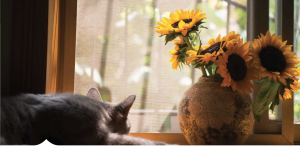 It has its paws folded under its bulky belly, face pressed against the swing hanging from the ceiling of a quiet living room. Its two hind legs are awkwardly draped over the side as it silently struggles not to fall off the seat. The suspense of being suspended in air doesn’t seem to bother it. One of its eyes, a thin slice of emerald, tracks a mosquito that zips around the room. The other eye is nowhere to be found. The cat doesn’t even twitch when an ancient air conditioner turns on and buzzes like a muffled jackhammer.
It has its paws folded under its bulky belly, face pressed against the swing hanging from the ceiling of a quiet living room. Its two hind legs are awkwardly draped over the side as it silently struggles not to fall off the seat. The suspense of being suspended in air doesn’t seem to bother it. One of its eyes, a thin slice of emerald, tracks a mosquito that zips around the room. The other eye is nowhere to be found. The cat doesn’t even twitch when an ancient air conditioner turns on and buzzes like a muffled jackhammer.
This kitten is a mystery, sitting for so long in such an uncomfortable position when it could be playing with its toys or lying on a comfy bed. Most people would be tempted to dismiss it as a failure, useless and unproductive. But a sedentary life is not necessarily an unrewarding one, and so many among us–cats and people alike–are driven by uncommon (but not unworthy) passions. A curious feline or human mind might be put to use studying the emotional effect of sleeping at various times on various couches, or seeing what happens if you roll your eyes back in your head too many times. These futile obsessions may only be relevant to those who pursue them. Even if they are accused of being boring, they secretly feel that their obsessions are the most intriguing, cutting-edge subject.
Such perseverance is like standing on a board precariously balanced on top of a ball. Staying stable is the difference between success and failure–lose your balance, and you’ll go tumbling to the ground as the ball rolls out of sight. It is frustrating that your audience has no sense of the sheer willpower it takes to stay still.
In the doorway of the living room, the little girl watches the cat and wistfully chews on one of her pigtails. This isn’t new for her. This lump of a cat seems eternally indifferent to her and to everything surrounding it, but maybe this time will be different…
Feet wearing socks like bubbles of pink gum thump across the floor. The porcelain trinkets on the rickety table clink against each other like faint windchimes over the sound of the girl’s delighted squeals.
There’s a twitch of an ear. A fully opened eye. The turning of a wide, swollen head towards the oncoming girl, whose pudgy outreached hands wake the cat from the reverie it worked so hard to maintain. Their two worlds collide like tornadoes, the overwhelming force of the impact blasting both of their ambitions into the air.
After hours of meditating in its own world, the kitten is paralyzed by shock. All is lost: the swing tips over and the cat rolls onto the ground. Its outstretched limbs twitch like those of a dying cockroach. The girl kneels by the swing, wondering why the cat has collapsed. For a minute, neither of them moves. Then slowly, the kitten rolls itself onto its feet and climbs back onto the swing, resuming its precarious position.
When I write, I am the cat on the swing, focusing entirely on maintaining my balance while girls run around in pink socks and other kittens chase after balls of string. Although it may look as though I am simply staring at a blank page for hours on end, behind this single-minded concentration is a flurry of mental activity: weaving threads of vivid observations, details, and anecdotes into a single, coherent piece. Lose your balance–lose your focus–and you have to start all over again.
Perseverance is a skill that I have cultivated through reading stories. I have explored new ways to find deeper meanings or common threads in my experiences and stories. This kind of thinking and writing takes a lot of concentration, as well as a commitment to tune out the thousands of distractions that grab at my attention. Sometimes when I’m writing on the hard floor against my locker in the hallway, staring at my laptop, I pause to listen to the tempting chatter of my classmates across the hall in the computer lab. Some are listening to music on their iPhones and gossiping; others are watching YouTube videos. Every so often the elevator door opens and a couple of my friends walk through, laughing at funny stories from the weekend. All the while, I keep my eyes glued to the words on my screen, until I cannot help but look up and call my friend over for a chat. The half-filled page looks daunting when I turn back to my computer, and I feel guilty for losing my thread of ideas–but I take a deep breath, regain my focus, and start typing again.
Stories can be about so many things, from family roots to dramatic descriptions of mindless tasks. They have taught me that everything contains a story, and it is the job of the writer to find and tell that story. Sometimes narratives reveal morals and truths that I had never thought about before, and as a reader of stories I have enthusiastically experienced authors’ discoveries through the words they write. Who knew that a story about a never-spoken-of aunt could help someone find her own identity? Or that a family picking apples could offer a lesson about freedom? Or that a cat falling off a swing might inspire me to become a better writer? The passion to look closer, to listen harder, and to find meaning in everyday situations is at the heart of all the stories that we have read–and the ones I hope to write someday.
Published on March 1, 2018 | In Blog, How To Begin Writing For Children, Independent, Hybrid and Self-Publishing | 0 Comment
by Aly Murphy February 20, 2018 http://murphysmanners.com/
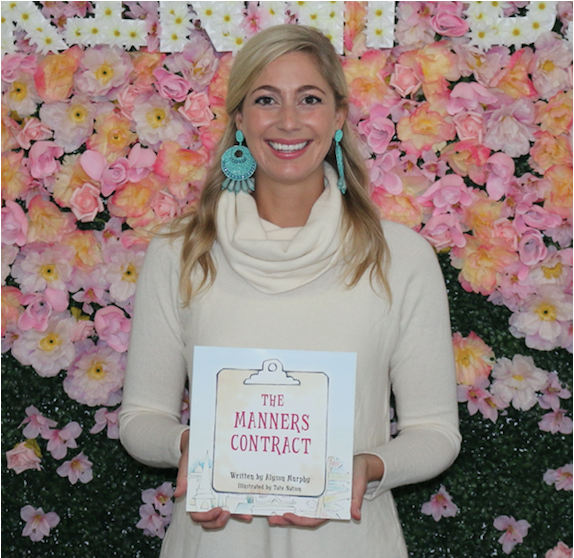 My passion for writing began in the fourth grade. It was 1998 and an author came to my school, Belle Hall Elementary, to have lunch with a few lucky students. I was selected for the lunch date after confidently sharing with my fourth-grade teacher, Ms. Peninger, that I too would one day write a book. On our last day of class, Ms. Peninger gave me a hardback journal with instructions to write in it all summer and come back as a fifth grader and share.
My passion for writing began in the fourth grade. It was 1998 and an author came to my school, Belle Hall Elementary, to have lunch with a few lucky students. I was selected for the lunch date after confidently sharing with my fourth-grade teacher, Ms. Peninger, that I too would one day write a book. On our last day of class, Ms. Peninger gave me a hardback journal with instructions to write in it all summer and come back as a fifth grader and share.
Fast forward to exactly twenty years later. I am sharing my book, The Manners Contract, with a group of 1stgrade students at Belle Hall Elementary and guess who walks in the room… You guessed it.. Ms. Peninger, now Mrs. Inglett! To my wonderful surprise Mrs. Inglett is still teaching 4th grade at Belle Hall Elementary and I am given the honor and privilege to come back a few weeks later and share this poetic journey with the entire fourth grade class. As I read the book to the shadows of my former 4th grade self, I often paused to explain the process that went into the creative writing, editing, illustrations and publishing. Just as Mrs. Inglett inspired me 20 years ago, I am inspired once again to continue this presentation – The Making of The Manners Contract – not only to the fourth graders at Belle Hall but to students of all ages all over the Lowcountry.
But this story hasn’t just resonated with students. It seems that everyone from my hair dresser to my Uber driver has an idea or story they would like to see come to fruition. While the book might have appeared to simply show up on amazon.com overnight, there was about a year of trial and error that went into nothing short of this labor of love.
So, if you are a fourth-grade student or a 64-year-old dreamer, I’ve compiled a list of my top six tips for getting your next story published.
1.Write about something you're familiar with. I teach manners and mindfulness classes so it was a no brainer that I would write a book on manners. A book can also be an extremely lucrative business tool so don’t waste an opportunity on a book about your dog. Or do.. it’s up to you!
2. Don’t do it for the money. According to Forbes the average income for a self-published author is under $5,000 while authors published by traditional publishers have a medium income range of $5,000-$9,000.
3. Find an editor you trust. If you are writing in rhyme it is crucial to find an editor who is an expert in rhythm and meter. If you are writing for YA find someone who can work with you on plot and pacing. Either way, find someone you can trust so that critiques feel like progress being made rather than personal attacks.
4. Understand basics behind traditional publishing vs. self-publishing vs. indie publishing. There are pros and cons for each. To publish traditionally you will need an agent and if you are not a celebrity, plan on at least 100 rejections and at least two years of further editing and marketing before your book hits shelves. Once it makes it to print, the royalty rate is on average only 10%. The positive side is that there are no upfront financial costs, in fact, they pay you an advance anywhere between $6,000-$10,000.
Self-publishing bypasses needing an agent and offers individuals custom publishing packages depending on their wants and needs. These packages range from $400-$6,000 and offer basic to advanced publishing services such as ISBN, copyright, design, print, etc. Again, the royalties are slim and it can take years to earn back your initial investment.
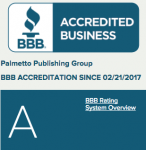 If you don’t necessarily care for being told no or giving the majority of your paycheck to a middle man (like myself) there is a third option called Independent Publishing aka Indie Publishing. I used a local independent publisher called Palmetto Publishing who was able to format my manuscript and illustrations and have the book in print and on amazon.com in less than two weeks! There is a small fee for formatting, but they take zero royalties. Speaking of illustrations, if you indie publish, you will have to hire a professional illustrator (this will cost 1k-6k) or create the illustrations yourself. I was incredibly lucky to have the opportunity to work with award winning artist, Tate Nation on my first book and have reached out to Charleston Artist Collective to interview local artists for book no. 2.
If you don’t necessarily care for being told no or giving the majority of your paycheck to a middle man (like myself) there is a third option called Independent Publishing aka Indie Publishing. I used a local independent publisher called Palmetto Publishing who was able to format my manuscript and illustrations and have the book in print and on amazon.com in less than two weeks! There is a small fee for formatting, but they take zero royalties. Speaking of illustrations, if you indie publish, you will have to hire a professional illustrator (this will cost 1k-6k) or create the illustrations yourself. I was incredibly lucky to have the opportunity to work with award winning artist, Tate Nation on my first book and have reached out to Charleston Artist Collective to interview local artists for book no. 2.
5. Take risks, embrace rejection and celebrate the rewards. To indie publish I had invest about 4k of my own money. 3k for the illustrations and another 1k in editing and publishing costs. When the book was finally available to purchase, I only had $18 left in my business account – that’s not even enough to buy a copy of my own book! Lucky for me, not too many schools are opposed to having a guest author share a lesson on manners for free. The money comes from the order forms I send home with students and my gratitude is debited to all the parents who have supported this 20- year-old fantasy turned reality. In only three months since the book launched, I’ve grossed double what most indie authors are predicted to make in a year. Not every school generates the number of orders I hope for, but when I get a school that does I make sure to celebrate!
6. Hustle. Nobody is going to sell your book better than you will. School readings have been my biggest motivator, but other avenues can be book signing parties, farmers markets, gift shops, children’s boutiques, etc. Last week, I even filled an order for a local car wash. There are no boundaries for your book when it is something you believe in and are willing to put in the time and effort to market, promote and sell.
So to Mrs. Inglett and all of the teachers who have dedicated their entire lives to the potential of their students, please know how much your hard work is valued and appreciated. The seeds you plant today (whether in 2 years or 20 years) become the roots that give us prospect and promise for the rest of our lives.
Aly Murphy is an international etiquette consultant based in Charleston, SC. She previously lived in Manhattan while she studied the history, social psychology and neuroscience of civility working with clients that ranged from former inmates to Wall Street executives. Aly discovered that while the rules of etiquette will continue to evolve and change over time, the need for acceptance and belonging remained timeless and at the core of our progressive society. When not working, Aly enjoys traveling, boating, chasing sunsets and hometeam.
Published on February 16, 2018 | In Blog, How To Begin Writing For Children | 0 Comment
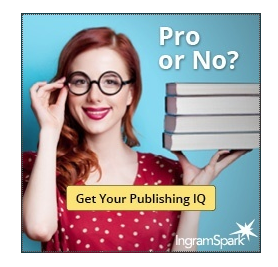 If your manuscript draft is complete, then you’re most likely celebrating getting each and every word down on paper. 2018 is your year and your book is coming out! With IngramSpark’s print-on-demand and global distribution, you’re ready to print your book and sell it to the masses! . . . Or are you?
If your manuscript draft is complete, then you’re most likely celebrating getting each and every word down on paper. 2018 is your year and your book is coming out! With IngramSpark’s print-on-demand and global distribution, you’re ready to print your book and sell it to the masses! . . . Or are you?
So many writers get caught up in the writing process that they completely forget that there are many steps between finishing the writing and putting a final book on a shelf or online. Being able to independently publish has changed book publishing for many talented writers—overstepping the traditional process of finding an agent and publisher means that for IngramSpark authors, getting to your book’s birthday can be expedited greatly.
However, there are some steps that you as a writer should never skip over, no matter how you choose to publish your book. At a publishing house, the editorial and proofing process can take a year, so having patience with your own book’s journey through this portion of the production process is vital to creating a wonderful book. The process that traditionally published writers go through has many valuable steps that are vital to putting a modern and polished product on the shelf, and IngramSpark authors have access to all of these same tools!
Here are some tips to make sure your book is going to compete in the marketplace.
Once you are satisfied that this book looks like what you want on bookstore shelves and other readers are used to seeing . . . go ahead and pick your book’s birthday (also known as a publication date) and celebrate. Remember, you will want to start working toward your publicity goals for several months before that birthdate, so don’t forget to keep that in mind as part of your planning process as well!